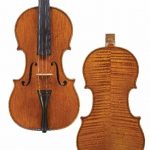Learning the finer points
Copyright © 2012 Franco Zanini, Alberto Giordano, The Strad magazine
Computed tomography (CT) is an analytical tool whose successful applications in the evaluation of bowed stringed instruments have been reported for the last fifteen years. The popularity of this technique is related to its non-invasive approach, absolutely necessary when applied to unique instruments of great historical, artistic and economical value. Nevertheless, the limitations of CT in the morphological analysis of violins are well known: the spatial resolution of the best clinical instruments, about 300 microns, does not allow a detailed description of important features such as cracks, condition of glue and fillers, presence of thin patches, activity of xylophages larvae and eggs. The limited dynamical range of this instruments, moreover, is a critical parameter when metal strings cannot be removed from the violin.
In order to overcome these problems, a multidisciplinary equipe of physicists, wood experts and luthiers has developed an innovative procedure which allows to obtain an accurate description of the general conditions and the pathologies of violas and violins. The experiment has been performed in Trieste where Elettra, one of the most advanced european particle accelerators, is routinely used by the international scientific community. It’s a synchrotron, an X-ray generator whose performances are unique for intensity (several order of magnitude higher compared with conventional instruments) and for the availability of many microscopic analytical tools. It is also possible to tune the X-ray wavelength as a function of the material under examination, while the coherence of the beam allows the detection of chemicals usually transparents to X-rays, such as glues or varnishes, even inside a dense sample. Using synchrotron radiation microtomography, an equipe formed by Diego Dreossi, Lucia Mancini, Nicola Sodini e Franco Zanini collaborated with the Correr Museum in Venice and the Cultural Heritage Office in Milan, allowing the first experiments on the 1494 paper-pipes organ of Lorenzo Gusnasco da Pavia and two flutes built by Johann Cristoph Denner at the beginning of the XVIII century. The information obtained at the SYRMEP beamline of Elettra allowed the organization of the ambitious project of a high-resolution 3D description of violins.
In order to obtain detailed morphological information from an instrument of the size of a violin, at the same time taking into account the peculiar characteristics of syncrotron radiation, the experimental team needed to use an X-ray detector with unique performances. This result was achieved thanks to the collaboration with local section of the italian National Institute for Nuclear Physics (INFN), thanks to the experience of this group in the development of particle physics instrumentation. A 50 micron resolution silicon microstrip detector, similar to the devices used at the CERN laboratory in Geneva for the study of subatomic particles and modified for applications in medical diagnostic, has been installed at SYRMEP for the first feasibility tests on a Stentor student violin with unbelievable results. A single tomographic image, equivalent to a virtual section of the whole violin at the level of the f-holes, allowed the researchers to visualize an impressive set of information. Even if the violin did not show any pathological feature typical of historical instruments, the images obtained with this experimental approach showed the present conditions of the violin together with information about the manufacturing techniques. It was also possible to confirm the kind of wood used for the single parts as well as to open a new insight on the dendrochronological approaches presently used to confirm the attribution of an instrument. The results of this experiment have been immediately spread in the both the communities of imaging scientists and luthiers, and the authors have been invited to the most important scientific conferences in the field of conservation and restoration of cultural heritage, from Ravenna to Somerset, from Petra to Sydney, from Florence to Phoenix.
After the success of the first data, the group from Trieste has repeated the experiment on an instrument of historical relevance: the 1753 violin by Giovanni Battista Guadagnini, presently owned and played by the norwegian Peter Herresthal (www.peterherresthal.com), an instrument built by the master from Piacenza during his first years of activity in Milan. Th main concern, in this case, has been the creation of the ideal environment for the sample during the data acquisition, that can reach times of approximately one hour. The best parameters for the conservation of cultural wood are well known, and should be around a percentage of 55-60% of relative humidity (RH) and a temperature of about 25 degrees centigrade, while the typical values experienced in a synchrotron laboratory do not exceed 15-20% RH and can reach a temperture of 30 degrees.
The temperature level is still acceptable, but the values of relative humidity can not be allowed for such a long time. In these condition a violin experiences a significant reduction in volume due to the loss of internal humidity of the wood, and important cracks or detachments of the diffrent parts can easily appear in the most delicate positions. In order to preserve the Guadagnini from these problems, a carefully designed system of environmental monitoring and control has been designed inside the experimental hutch of SYRMEP. A first, simple stage is made just with a humidifier coupled with an air conditioning system, in order to create an environment with a RH value of 40% +/- 5% and a temperature of 25 °C. A more precise environmental stage has been developed around the violin thanks to a plexiglass box of size 50x50x130 cm equipped with a Microclimate MCG4 humidity control system. Thanks to the positive pressure inside the box, the control system is able to maintain the desired RH value with a tolerance of 1-2%. Any deviation from the desigend values of more than 5% in RH or 5 °C in temperature sets an alarm in the control room of the experiment. The first stage, not only guarantees the correct performance of the second, but is able to prepare the ideal conditions for the preparation and the exposition of the violin before and after the tomographic acquisition.
This setup has allowed the control of the environmental parameters in the plexiglass box within the design limits during the whole experiments, but the most important feedback came from the sensibility and the experience of Peter Herresthal, who played the Guadagnini immediately after the tomography and confirmed that the performance of the violin did not show any difference in the sound. The whole system has been designed and built with the financial help of Cividin Costruzioni, an italian company whose interest in the applications of new technologies in the field of cultural heritage in not new.
These data, taken in collaboration with the italian luthier Alberto Giordano, have revealed details on the structure of the Guadagnini which were absolutely impossible to detect with other techniques: synchrotron radiation microtomography, is an extremely powerful technique in the field of diagnostic analysis of bowed stringed instruments: it is absolutely non-destructive and non-invasive, and allows to obtain three-dimensional microstructural information in digital format. In this way the data are easy to understand and manage, with the possibility to resolve details down to 50 microns. The complexity of the instrumentation is not compatible with general screening applications, and the methodology can be applied to important studies or to objects of great values. But shows again that the collaboration between different communities implied in the study of historical musical instruments allows to obtain important results. the presence in Europe of scientists and technicians of absolute level, like the equipes at Elettra and INFN, of institutions and foundations related to the world of restoration and conservation of ancient musical instruments should encourage us to reach increasing levels of eccellence through new forms of collaboration and, as a consequence, new ideas and analytical approaches.
Franco Zanini
The investigation on the Guadagnini violin
The violin subject of the investigation at the Synchrotron Elettra in Trieste is a fine example of the work of J.B.Guadagnini, property of norwegian violin player Peter Herresthal, who generously volunteered to submit his violin to the synchrotron x-ray flow. The violin was acquired by Herresthal with the help of Bernt Fossum, a norwegian mecenate in the music field, at Brompton’s in 2006 for the record price (at those times) of 4.250.000 NOK; made in Milano in 1753, the violin shows Guadagnini’s mature style characterized by oval lower ef-holes holes, elegant edge-work and light orange brown oil varnish; the violin reveals a rich and powerful sound especially on high treble notes.
The first shot shows the interior of the violin ‘sliced’ at the height of the lower central blocks; the image is astonishingly sharp and well defined and it gives detailed information about the interior of the violin: in particular one can immediately see restoration works like the semi-borders on the bass side of the belly, a double patch in the chest area, a reinforcement cleat aside the treble ef-hole, the insertion of the linings in the blocks with little airspaces produced by the maker’s knife. In the blow-up are also clearly visible two small holes produced by insects and the granular consistency of the glue that set the sides to the blocks; in the belly the crack on the left is perfectly evident as well as the growth rings of the spruce.
In the second image, taken at the lower bout’s maximum height, it is possible to see the cleats reinforcing two cracks on the belly and another cleat fixing the crack to the bass-bar; the quality of the picture allows perfect measuring of the thickness of the plates, of the sides and of the curves of the arching.
Synchrotron microtomographic inspection sounds today as a unique tool in violin investigation; the restriction in the use is given by the difficulty to make this technique easy available to studiers, musicians and luthiers, since Synchrotron laboratories are not always easily reachable, the investigation process needs a number of scientists and researchers and generally a huge organization; on the other side the possibilities that this process can bring in the knowledge of classical lutherie and in the conservation of historical violin are enormous: one of these possibilities is to get extremely reliable measurements of the wood rings that will allow to set a step ahead in dendrochronology dating technique, due to the tridimensional approach to the analysis of the growth rings.
In general Synchrotron microtomographic inspection seems to match perfectly the needs of the world aristocracy of violins, by means all those instruments held in public collections, museums or foundations, that are preserved and protected from the use: for those ‘historical instruments’, like for instance the ‘Messiah’, the ‘Cannone’, the Stradivari ‘Medici’ tenor viola, this investigation technique can create a portfolio of data on static and microstatic condition of the instrument that are precious for future comparison; it also gives the opportunity to carefully measure arching distortions, to check the internal situation of the instrument (neck sets, cracks, insects damages) giving information that can avoid an opening or a restoration works, information that are essential for the conservation purpose.
Alberto Giordano





